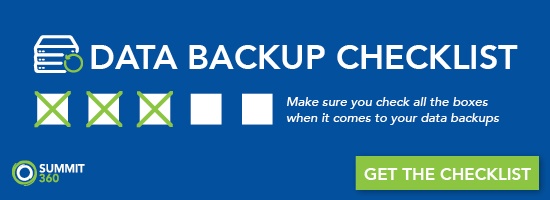When you work with an ITAD provider, the service you receive is your IT assets’ disposition. But the real product – the deliverable that’s often overlooked – is the final reporting. Because accurate and complete reporting is critical to maintaining your company’s compliance, a spreadsheet is not enough.
You want an ITAD vendor who understands the importance of having a robust, fully integrated Enterprise Resource Planning (ERP) system in place. An ERP that provides you with complete, accurate, and transparent reporting and brings together most, if not all, of the following:
- CRM (sales and client)
- Logistics (the transportation of equipment)
- Processing (the disposition of assets)
- Inventory Control (where assets are located)
- Sales (consignment of your refurbished equipment)
- Quality Control (checks and balances)
- HR (employee metrics and management)
- Accounting & Financial Management
The advantages of a strong ERP system for ITAD vendors
As a CIO or IT manager, you may have concerns about steps within the ITAD process itself, including:
- Physical security
- Data security
- Environmental compliance
- Brand protection
- Certifications, insurance, contractual requirements
If you’re committed to mitigating every possible risk in the ITAD process, then you also need to consider the risks associated with final reporting. Specifically, does your report have:
- Complete data
- Transparent data
- Process integrity
- Systems integrity
Why the scrutiny? Your report is evidence that you did all the right things (e.g., if you have a data breach or environmental issue, you’ll know it wasn’t from improperly retiring equipment). And the links between ITAD process areas and an ERP’s reporting can provide meaningful feedback to you on process quality and data accuracy.
Following is more information about what to look for in your ITAD vendor’s ERP system to guarantee you have an audit trail for every single asset.
ERP for ITAD: Report completeness
When you receive a report from your ITAD vendor, make sure it includes all of the fields you want to track. You’ll want more than just a serial number, make and model. The report should also include:
- Client asset tag (if you use them for asset management)
- Details about the asset’s configuration
- Details about the asset’s status (was it wiped? Destroyed? Recycled? Resold?)
Also, reports should be completed on a timely basis. From the time an ITAD vendor receives your equipment to the time you have a report in your hands should be about 30 days. In terms of completeness, reports should be flexible enough to include multiple shipments of assets within a defined period.
Finally, the most important reason to have an ERP for ITAD is to ensure your report is complete enough to be used as an audit trail. Confirm it includes all of the information you want and need and that it’s strong enough that an auditor will accept it.
ERP for ITAD: Reporting transparency
In terms of transparency, you want to make sure the report is consistent with other reports you use and includes data about the full ITAD process.
Some clients reconcile and do checks and balances against their internal reports. Other clients do their own serialization before they send assets to the ITAD vendor. Afterward, they use their own data to compare against the vendor’s report. And yet others don’t have the resources to do this internally and trust their vetted ITAD vendor to provide full reporting.
Whichever process you use, a periodic spot check is recommended to ensure the report is transparent and consistent with your contract. This is especially true when it comes to fee calculations and revenue share (for consignment assets). You want to ensure there’s nothing in the report you didn’t agree to, or that seems doctored in any way.

ERP for ITAD: Process integrity
When an ERP is programmed to manage the ITAD process, it forces the user to complete it correctly. That, in turn, ensures the data is accurately captured and the process was fully completed. This is another advantage to using an ERP system – your report is a record of the process your assets went through.
Because people and systems are involved, process breakdowns are possible. In these cases, even if reports are complete (include everything) and transparent (true to what happened), they may include insufficient data.
The critical question for you to ask your vendor is: “Do you have checks and balances in the process to ensure that accurate data is generated?” Put another way, will the ERP system alert you if something is entered incorrectly or an anomaly occurs in the process?
Ideally, you want quality assurance measures that double-check the process between you and the vendor as well as the vendor’s ITAD process itself. These additional measures validate the process was completed correctly and your data is accurate.
ERP for ITAD: Systems integrity
To the extent they’re integrated, systems tie all of the ITAD pieces together for you. For example, integrated ERP systems:
- Provide the basis for all reporting and financial calculations
- Capture process status and equipment audit information
- Provide internal controls on the physical process
- Ensure that accurate data is being captured
Many ITAD vendors have chosen the lowest cost approach to ERPs and have separate systems for warehouse management, process management, CRM, sales, accounting, and finance. These disparate systems can easily get out of sync and be difficult to maintain – put simply, they are inadequate for managing a process as sensitive as ITAD. As such, be sure to ask your ITAD vendor how they ensure their ERP system’s integrity through integration across functions.
Are their systems designed well to accomplish your objective? Can they configure for and handle reverse logistics? Do they have adequate change controls in place? Does their testing ensure nothing else was affected by the change? Do you have any control over that?
These are all important elements of ERP for ITAD. Any time you’re making changes to a system that underpins a process, you want to ensure strict controls are in place.
The new ITAD standard: An ERP in the cloud
In the past, ERPs were on servers or stored in a data closet. Today, integrated ERPs based in the cloud provides the most robust, resilient, and agile solution:
- Robust to support various enterprise customers and their processes
- Resilient to ensure you’ll be largely unaffected by faults or outages
- Agile to allow for adjustments based on your current and changing business needs, including customization for ITAD reverse logistics and special client requirements
And it shouldn’t just be a cloud-based approach. It’s important for your ITAD vendor to have an ERP system that is both strong (managed and supported by a world-class systems provider) and a development platform (capable of being customized to fit the business need without affecting the underlying integrity).
Find an ITAD vendor who’s made an ERP investment
Companies rely on their ITAD vendors to mitigate every possible risk on their behalf. Sophisticated ITAD vendors know that an ERP system ensures data accuracy and systems integrity; however, because a robust, fully integrated ERP can be a large investment, many ITAD vendors don’t have one. Instead, they’re using manual spreadsheets or low-cost ERPs to collect and report the data you need – with few if any controls.
Because many clients don’t understand these risks or don’t know there’s an alternative, they just accept what’s given to them.
With regulations and compliance requirements changing all the time, the importance of a strong integrated ERP system cannot be overstated. Find an ITAD vendor who’s invested in supporting their process and offering you the highest quality reporting available.
Want to learn more about the importance of strong ERP systems for ITAD? Contact us today.





